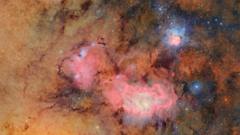In April, astronomers excitedly speculated that they had found possible signs of life on the exoplanet K2-18b, located over 120 light-years from Earth. However, skepticism arose as experts began re-evaluating the data, and three independent analyses have confirmed that there is no convincing evidence of life on this distant planet. Luis Welbanks, an astronomer at Arizona State University and co-author of one of the studies, stated, "The claim just absolutely vanishes."
The real issue isn’t about alien life; it's about the difficulties in observing far-off planets. Unlike our nearby Jupiter, which reflects sunlight that makes it visible, K2-18b is too distant to be seen with traditional telescopes. To gather data, astronomers have developed sophisticated methods to analyze the stars and their orbiting planets, allowing hints about their atmospheres to emerge.
In 2010, they gained insight into GJ 1214b, a planet closer to Earth, by observing its transit in front of its star, revealing signs of water vapor in its atmosphere. Recently, they have turned to the James Webb Space Telescope, a powerful tool designed to uncover intricate details about the atmospheres of distant worlds by analyzing subtle changes in starlight. Despite the excitement, the search for extraterrestrial life is a challenging journey!























